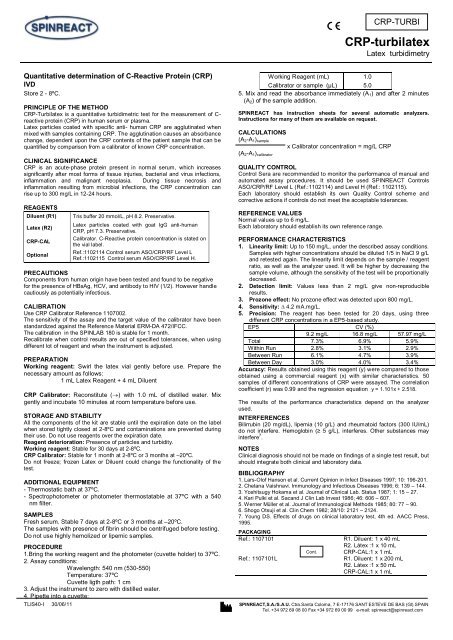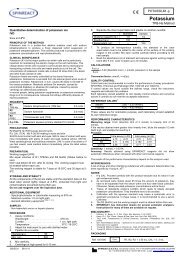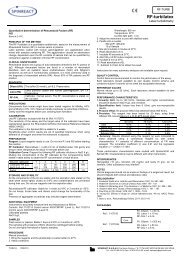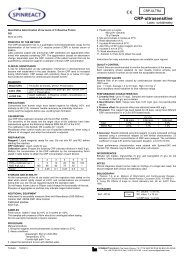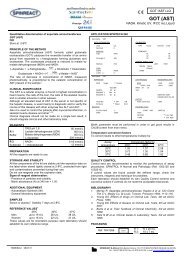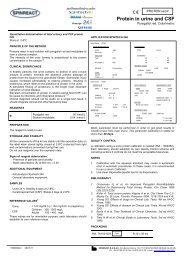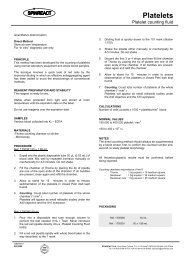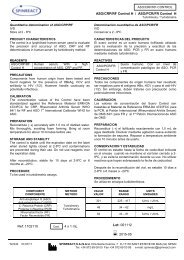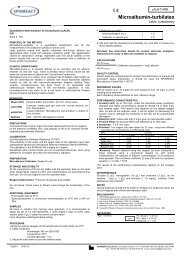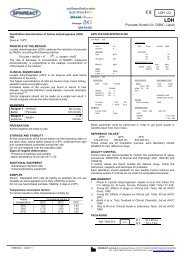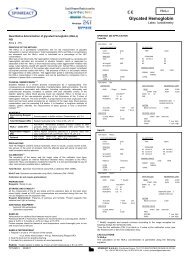CRP-turbilatex
CRP-turbilatex - Spinreact
CRP-turbilatex - Spinreact
- No tags were found...
Create successful ePaper yourself
Turn your PDF publications into a flip-book with our unique Google optimized e-Paper software.
<strong>CRP</strong>-TURBI<br />
<strong>CRP</strong>-<strong>turbilatex</strong><br />
Latex turbidimetry<br />
Quantitative determination of C-Reactive Protein (<strong>CRP</strong>)<br />
IVD<br />
Store 2 - 8ºC.<br />
PRINCIPLE OF THE METHOD<br />
<strong>CRP</strong>-Turbilatex is a quantitative turbidimetric test for the measurement of C-<br />
reactive protein (<strong>CRP</strong>) in human serum or plasma.<br />
Latex particles coated with specific anti- human <strong>CRP</strong> are agglutinated when<br />
mixed with samples containing <strong>CRP</strong>. The agglutination causes an absorbance<br />
change, dependent upon the <strong>CRP</strong> contents of the patient sample that can be<br />
quantified by comparison from a calibrator of known <strong>CRP</strong> concentration.<br />
CLINICAL SIGNIFICANCE<br />
<strong>CRP</strong> is an acute-phase protein present in normal serum, which increases<br />
significantly after most forms of tissue injuries, bacterial and virus infections,<br />
inflammation and malignant neoplasia. During tissue necrosis and<br />
inflammation resulting from microbial infections, the <strong>CRP</strong> concentration can<br />
rise up to 300 mg/L in 12-24 hours.<br />
REAGENTS<br />
Diluent (R1)<br />
Latex (R2)<br />
<strong>CRP</strong>-CAL<br />
Optional<br />
Tris buffer 20 mmol/L, pH 8.2. Preservative.<br />
Latex particles coated with goat IgG anti-human<br />
<strong>CRP</strong>, pH 7.3. Preservative.<br />
Calibrator. C-Reactive protein concentration is stated on<br />
the vial label.<br />
Ref.:1102114 Control serum ASO/<strong>CRP</strong>/RF Level L<br />
Ref.:1102115 Control serum ASO/<strong>CRP</strong>/RF Level H.<br />
PRECAUTIONS<br />
Components from human origin have been tested and found to be negative<br />
for the presence of HBsAg, HCV, and antibody to HIV (1/2). However handle<br />
cautiously as potentially infectious.<br />
CALIBRATION<br />
Use <strong>CRP</strong> Calibrator Reference 1107002.<br />
The sensitivity of the assay and the target value of the calibrator have been<br />
standardized against the Reference Material ERM-DA 472/IFCC.<br />
The calibration in the SPINLAB 180 is stable for 1 month.<br />
Recalibrate when control results are out of specified tolerances, when using<br />
different lot of reagent and when the instrument is adjusted.<br />
PREPARATION<br />
Working reagent: Swirl the latex vial gently before use. Prepare the<br />
necessary amount as follows:<br />
1 mL Latex Reagent + 4 mL Diluent<br />
<strong>CRP</strong> Calibrator: Reconstitute ( ) with 1.0 mL of distilled water. Mix<br />
gently and incubate 10 minutes at room temperature before use.<br />
STORAGE AND STABILITY<br />
All the components of the kit are stable until the expiration date on the label<br />
when stored tightly closed at 2-8ºC and contaminations are prevented during<br />
their use. Do not use reagents over the expiration date.<br />
Reagent deterioration: Presence of particles and turbidity.<br />
Working reagent: Stable for 30 days at 2-8ºC.<br />
<strong>CRP</strong> Calibrator: Stable for 1 month at 2-8ºC or 3 months at –20ºC.<br />
Do not freeze; frozen Latex or Diluent could change the functionality of the<br />
test.<br />
ADDITIONAL EQUIPMENT<br />
- Thermostatic bath at 37ºC.<br />
- Spectrophotometer or photometer thermostatable at 37ºC with a 540<br />
nm filter.<br />
SAMPLES<br />
Fresh serum. Stable 7 days at 2-8ºC or 3 months at –20ºC.<br />
The samples with presence of fibrin should be centrifuged before testing.<br />
Do not use highly hemolized or lipemic samples.<br />
PROCEDURE<br />
1.Bring the working reagent and the photometer (cuvette holder) to 37ºC.<br />
2. Assay conditions:<br />
Wavelength: 540 nm (530-550)<br />
Temperature: 37ºC<br />
Cuvette ligth path: 1 cm<br />
3. Adjust the instrument to zero with distilled water.<br />
4. Pipette into a cuvette:<br />
Working Reagent (mL) 1.0<br />
Calibrator or sample (µL) 5.0<br />
5. Mix and read the absorbance immediately (A 1) and after 2 minutes<br />
(A 2) of the sample addition.<br />
SPINREACT has instruction sheets for several automatic analyzers.<br />
Instructions for many of them are available on request.<br />
CALCULATIONS<br />
(A 2-A 1) sample<br />
x Calibrator concentration = mg/L <strong>CRP</strong><br />
(A 2-A 1) calibrator<br />
QUALITY CONTROL<br />
Control Sera are recommended to monitor the performance of manual and<br />
automated assay procedures. It should be used SPINREACT Controls<br />
ASO/<strong>CRP</strong>/RF Level L (Ref.:1102114) and Level H (Ref.: 1102115).<br />
Each laboratory should establish its own Quality Control scheme and<br />
corrective actions if controls do not meet the acceptable tolerances.<br />
REFERENCE VALUES<br />
Normal values up to 6 mg/L.<br />
Each laboratory should establish its own reference range.<br />
PERFORMANCE CHARACTERISTICS<br />
1. Linearity limit: Up to 150 mg/L, under the described assay conditions.<br />
Samples with higher concentrations should be diluted 1/5 in NaCl 9 g/L<br />
and retested again. The linearity limit depends on the sample / reagent<br />
ratio, as well as the analyzer used. It will be higher by decreasing the<br />
sample volume, although the sensitivity of the test will be proportionally<br />
decreased.<br />
2. Detection limit: Values less than 2 mg/L give non-reproducible<br />
results.<br />
3. Prozone effect: No prozone effect was detected upon 800 mg/L.<br />
4. Sensitivity: 4.2 mA.mg/L.<br />
5. Precision: The reagent has been tested for 20 days, using three<br />
different <strong>CRP</strong> concentrations in a EP5-based study.<br />
EP5 CV (%)<br />
9.2 mg/L 16.8 mg/L 57.97 mg/L<br />
Total 7.3% 6.9% 5.9%<br />
Within Run 2.8% 3.1% 2.9%<br />
Between Run 6.1% 4.7% 3.9%<br />
Between Day 3.0% 4.0% 3.4%<br />
Accuracy: Results obtained using this reagent (y) were compared to those<br />
obtained using a commercial reagent (x) with similar characteristics. 50<br />
samples of different concentrations of <strong>CRP</strong> were assayed. The correlation<br />
coefficient (r) was 0.99 and the regression equation y = 1.101x + 2.518.<br />
The results of the performance characteristics depend on the analyzer<br />
used.<br />
INTERFERENCES<br />
Bilirrubin (20 mg/dL), lipemia (10 g/L) and rheumatoid factors (300 IU/mL)<br />
do not interfere. Hemoglobin (≥ 5 g/L), interferes. Other substances may<br />
interfere 7 .<br />
NOTES<br />
Clinical diagnosis should not be made on findings of a single test result, but<br />
should integrate both clinical and laboratory data.<br />
BIBLIOGRAPHY<br />
1. Lars-Olof Hanson et al. Current Opinion in Infect Diseases 1997; 10: 196-201.<br />
2. Chetana Vaishnavi. Immunology and Infectious Diseases 1996; 6: 139 – 144.<br />
3. Yoshitsugy Hokama et al. Journal of Clinical Lab. Status 1987; 1: 15 – 27.<br />
4. Kari Pulki et al. Sacand J Clin Lab Invest 1986; 46: 606 – 607.<br />
5. Werner Müller et al. Journal of Immunological Methods 1985; 80: 77 – 90.<br />
6. Shogo Otsuji et al. Clin Chem 1982; 28/10: 2121 – 2124.<br />
7. Young DS. Effects of drugs on clinical laboratory test, 4th ed. AACC Press,<br />
1995.<br />
PACKAGING<br />
Ref.: 1107101<br />
Ref.: 1107101L<br />
R1. Diluent: 1 x 40 mL<br />
R2. Látex :1 x 10 mL<br />
<strong>CRP</strong>-CAL:1 x 1 mL<br />
R1. Diluent: 1 x 200 mL<br />
R2. Látex :1 x 50 mL<br />
<strong>CRP</strong>-CAL:1 x 1 mL<br />
TLIS40-I 30/06/11 SPINREACT,S.A./S.A.U. Ctra.Santa Coloma, 7 E-17176 SANT ESTEVE DE BAS (GI) SPAIN<br />
Tel. +34 972 69 08 00 Fax +34 972 69 00 99 e-mail: spinreact@spinreact.com<br />
Cont.
<strong>CRP</strong>-TURBI<br />
PCR-turbilátex<br />
Turbidimetría Látex<br />
Determinación cuantitativa de Proteína C-Reactiva (PCR)<br />
IVD<br />
Conservar a 2 - 8ºC.<br />
PRINCIPIO DEL MÉTODO<br />
PCR-Turbilátex es un ensayo turbidimétrico para la cuantificación de proteína<br />
C-reactiva (PCR) en suero o plasma humano.<br />
Las partículas de látex recubiertas con anticuerpos anti-PCR humana, son<br />
aglutinadas por PCR presente en la muestra del paciente. El proceso de<br />
aglutinación provoca un cambio de absorbancia proporcional a la<br />
concentración de PCR de la muestra, y por comparación con un calibrador de<br />
PCR de concentración conocida se puede determinar el contenido de PCR en<br />
la muestra ensayada.<br />
SIGNIFICADO CLÍNICO<br />
La Proteína C-reactiva es una proteína de fase aguda, presente en el suero de<br />
pacientes sanos, la cual puede incrementarse significativamente en la mayoría<br />
de procesos infecciosos bacterianos y virales, tejidos dañados, inflamación y<br />
neoplasias malignas. El incremento de concentración de esta proteína se<br />
produce después de unas horas de desarrollarse la inflamación pudiendo<br />
alcanzar niveles de 300 mg/L en 12-24 horas.<br />
REACTIVOS<br />
Diluyente (R1)<br />
Látex (R2)<br />
<strong>CRP</strong>-CAL<br />
Opcional<br />
Tampón tris 20 mmol/L, pH 8,2. Conservante.<br />
Partículas de látex cubiertas de IgG de cabra anti-PCR<br />
humana, pH, 7,3. Conservante.<br />
Calibrador. La concentración de PCR viene indicada en la<br />
etiqueta del vial.<br />
Ref: 1102114 Suero Control ASO/PCR/FR Nivel L<br />
Ref: 1102115 Suero Control ASO/PCR/FR Nivel H<br />
PRECAUCIONES<br />
Todos los componentes de origen humano han resultado ser negativos para el<br />
antígeno HBs, HCV y para el anti-HIV (1/2). Sin embargo, deben tratarse con<br />
precaución como potencialmente infecciosos.<br />
CALIBRACIÓN<br />
Usar el Calibrador PCR Referencia 1107002.<br />
La sensibilidad del ensayo y el valor de concentración del Calibrador están<br />
estandarizados frente el Material de Referencia ERM-DA 472/IFCC.<br />
La calibración en el SPINLAB 180 es estable durante 1 mes.<br />
Recalibrar cuando los resultados del control están fuera de especificaciones,<br />
cuando se usa diferente lote de reactivo y cuando se ajusta el instrumento.<br />
PREPARACIÓN<br />
Reactivo de Trabajo: Homogeneizar el Reactivo de Látex con suavidad antes<br />
de diluirlo. Preparar la cantidad necesaria según la siguiente proporción:<br />
1 mL Reactivo Látex + 4 mL Reactivo Diluyente<br />
Calibrador de PCR: Reconstituir ( ) el liofilizado con 1,0 mL de agua<br />
destilada. Mezclar con suavidad y dejar 10 minutos en reposo antes de<br />
usarlo.<br />
CONSERVACIÓN Y ESTABILIDAD<br />
Todos los componentes del kit son estables hasta la fecha de caducidad<br />
indicada en el envase cuando se mantienen los viales bien cerrados a 2-8ºC, y<br />
se evita la contaminación durante su uso. No utilizar reactivos que hayan<br />
sobrepasado la fecha de caducidad.<br />
Indicadores de deterioro de los reactivos: Presencia de partículas y<br />
turbidez.<br />
Reactivo de Trabajo: Estable 30 días a 2-8ºC.<br />
Calibrador reconstituido: Estable 1 mes a 2-8ºC ó 3 meses a –20ºC.<br />
La congelación de los reactivos de Látex y Diluyente altera<br />
irreversiblemente la funcionalidad de los mismos.<br />
MATERIAL ADICIONAL<br />
- Baño de agua a 37ºC.<br />
- Espectrofotómetro o fotómetro con cubeta termostatizable a 37ºC para<br />
lecturas a 540 nm.<br />
MUESTRAS<br />
Suero fresco. Estable 7 días a 2-8ºC o 3 meses a -20ºC.<br />
Las muestras con restos de fibrina deben ser centrifugadas antes de usar.<br />
No utilizar muestras altamente hemolizadas o lipémicas.<br />
PROCEDIMIENTO<br />
1.Calentar el Reactivo de Trabajo y el fotómetro (portacubetas) a 37ºC.<br />
2. Condiciones del ensayo:<br />
Longitud de onda: 540 nm (530 – 550)<br />
Temperatura: 37ºC<br />
Paso de luz de la cubeta: 1 cm<br />
3. Ajustar el espectrofotómetro a cero frente a agua destilada.<br />
4. Pipetear en una cubeta:<br />
Reactivo de Trabajo (mL) 1,0<br />
Calibrador o muestra (µL) 5,0<br />
5. Mezclar y leer la absorbancia frente al blanco inmediatamente (A 1) y a<br />
los 2 minutos (A 2) de efectuada la mezcla.<br />
Spinreact dispone de adaptaciones detalladas a la mayoría de analizadores<br />
automáticos del mercado. Solicite la información a su distribuidor.<br />
CÁLCULOS<br />
(A 2-A 1) muestra<br />
(A 2-A 1) Calibrador<br />
x Concentración del Calibrador = mg/L PCR<br />
CONTROL DE CALIDAD<br />
Se recomienda utilizar sueros control para controlar los ensayos tanto en<br />
procedimiento manual como en automático. Debe usarse el control de<br />
SPINREACT ASO/PCR/FR nivel L (Ref: 1102114) y nivel H (Ref: 1102115).<br />
Cada laboratorio debería establecer su propio Control de Calidad y<br />
establecer correcciones en el caso de que los controles no cumplan con<br />
las tolerancias exigidas.<br />
VALORES DE REFERENCIA<br />
Valores normales hasta 6 mg/L.<br />
Es recomendable que cada laboratorio establezca sus propios valores de<br />
referencia.<br />
CARACTERÍSTICAS DEL MÉTODO<br />
1. Límite de linealidad: hasta 150 mg/L, en las condiciones descritas del<br />
ensayo. Muestras con concentraciones superiores deben diluirse 1/5 en<br />
NaCl 9 g/L y ensayarse de nuevo. La linealidad puede variar en función<br />
del analizador o espectrofotómetro utilizado, así como de la relación<br />
muestra/reactivo. Disminuyendo el volumen de muestra, se aumenta el<br />
límite superior de linealidad, aunque se reduce la sensibilidad.<br />
2. Límite de detección: Valores por debajo de 2 mg/L dan lugar a<br />
resultados poco reproducibles.<br />
3. Efecto prozona: No se observa efecto prozona hasta valores de 800<br />
mg/L.<br />
4. Sensibilidad: 4,2 mA.mg/L.<br />
5. Precisión: El reactivo ha sido probado durante 20 días con tres<br />
concentraciones diferentes de PCR en un estudio basado en las normas EP5<br />
(NCCLS).<br />
EP5 CV (%)<br />
9.2 mg/L 16.8 mg/L 57.97 mg/L<br />
Total 7.3% 6.9% 5.9%<br />
Within Run 2.8% 3.1% 2.9%<br />
Between Run 6.1% 4.7% 3.9%<br />
Between Day 3.0% 4.0% 3.4%<br />
6. Exactitud: El comportamiento de este método (y) fue comparado con otro<br />
método (x) de características similares. 50 muestras de diferentes<br />
concentraciones de PCR fueron analizadas con ambos métodos. El coeficiente<br />
de regresión (r) fue de 0,99 y la ecuación de la recta de regresión y = 1.101x +<br />
2.518.<br />
Las características del método pueden variar según el analizador utilizado.<br />
INTERFERENCIAS<br />
Bilirrubina (20 mg/dL), lípidos (10 g/L) y factores reumatoides (300 UI/mL)<br />
no interfieren. La hemoglobina (≥ 5 g/L), interfiere. Otras sustancias<br />
pueden interferir 7 .<br />
NOTAS<br />
El diagnóstico clínico no debe realizarse únicamente con los resultados de<br />
un único ensayo, sino que debe considerarse al mismo tiempo los datos<br />
clínicos del paciente.<br />
BIBLIOGRAFÍA<br />
1. Lars-Olof Hanson et al. Current Opinion in Infectious diseases 1997; 10: 196-201.<br />
2. Chetana Vaishnavi. Immunology and Infectious Diseases 1996; 6: 139 – 144.<br />
3. Yoshitsugy Hokama et al. Journal of Clinical Laboratory Status 1987; 1: 15 – 27.<br />
4. Kari Pulki et al. Sacand J Clin Lab Invest 1986; 46: 606 – 607.<br />
5. Werner Müller et al. Journal of Immunological Methods 1985; 80: 77 – 90.<br />
6. Shogo Otsuji et al. Clin Chem 1982; 28/10: 2121 – 2124.<br />
7. Young DS. Effects of drugs on clinical laboratory test, 4th ed. AACC Press, 1995.<br />
PRESENTACIÓN<br />
Ref.: 1107101<br />
Ref.: 1107101L<br />
R1. Diluyente: 1 x 40 mL<br />
R2. Látex :1 x 10 mL<br />
<strong>CRP</strong>-CAL:1 x 1 mL<br />
R1. Diluyente: 1 x 200 mL<br />
R2. Látex :1 x 50 mL<br />
<strong>CRP</strong>-CAL:1 x 1 mL<br />
TLIS40-E 30/06/11 SPINREACT,S.A./S.A.U. Ctra.Santa Coloma, 7 E-17176 SANT ESTEVE DE BAS (GI) SPAIN<br />
Tel. +34 972 69 08 00 Fax +34 972 69 00 99 e-mail: spinreact@spinreact.com<br />
Cont.


